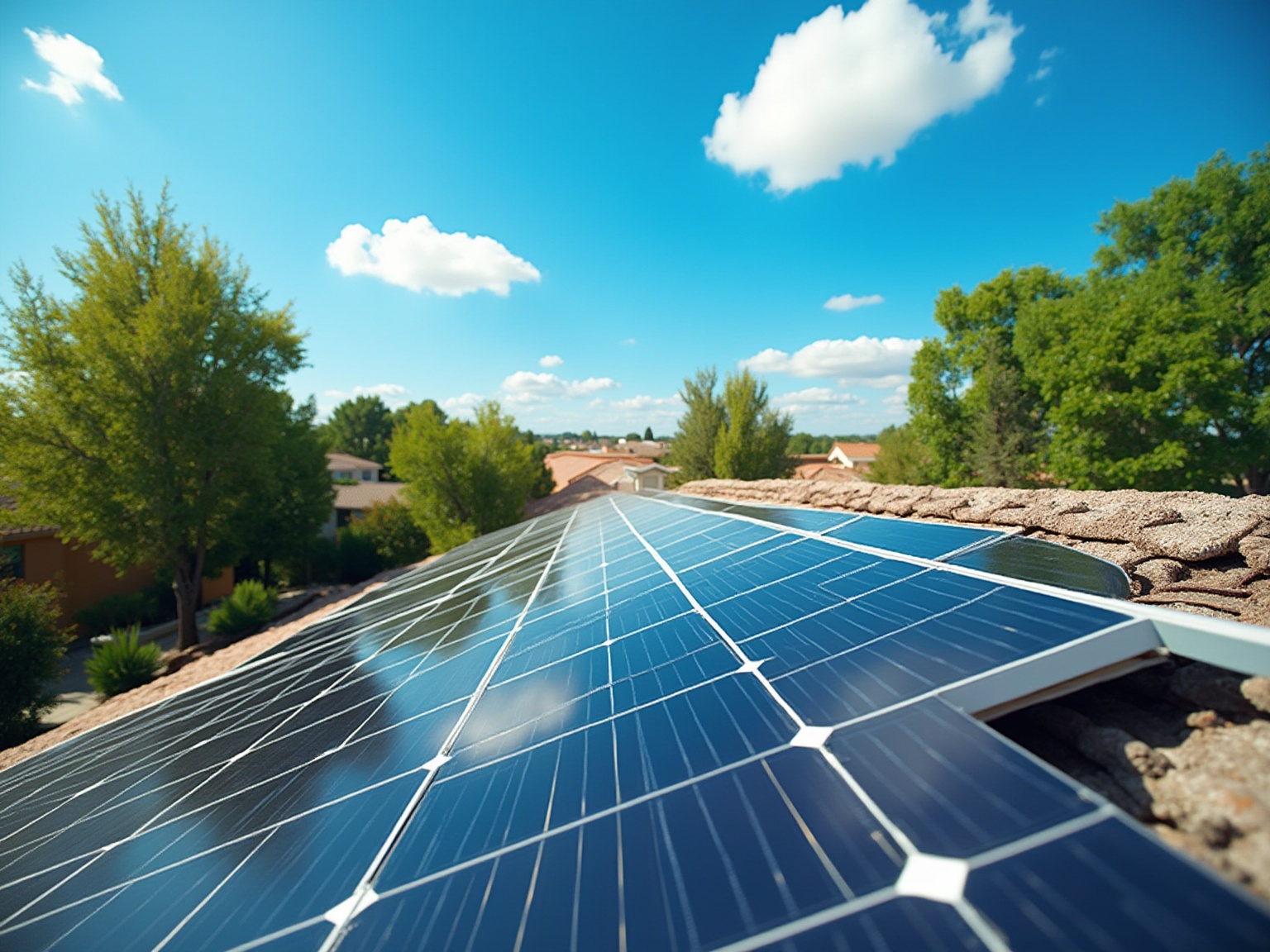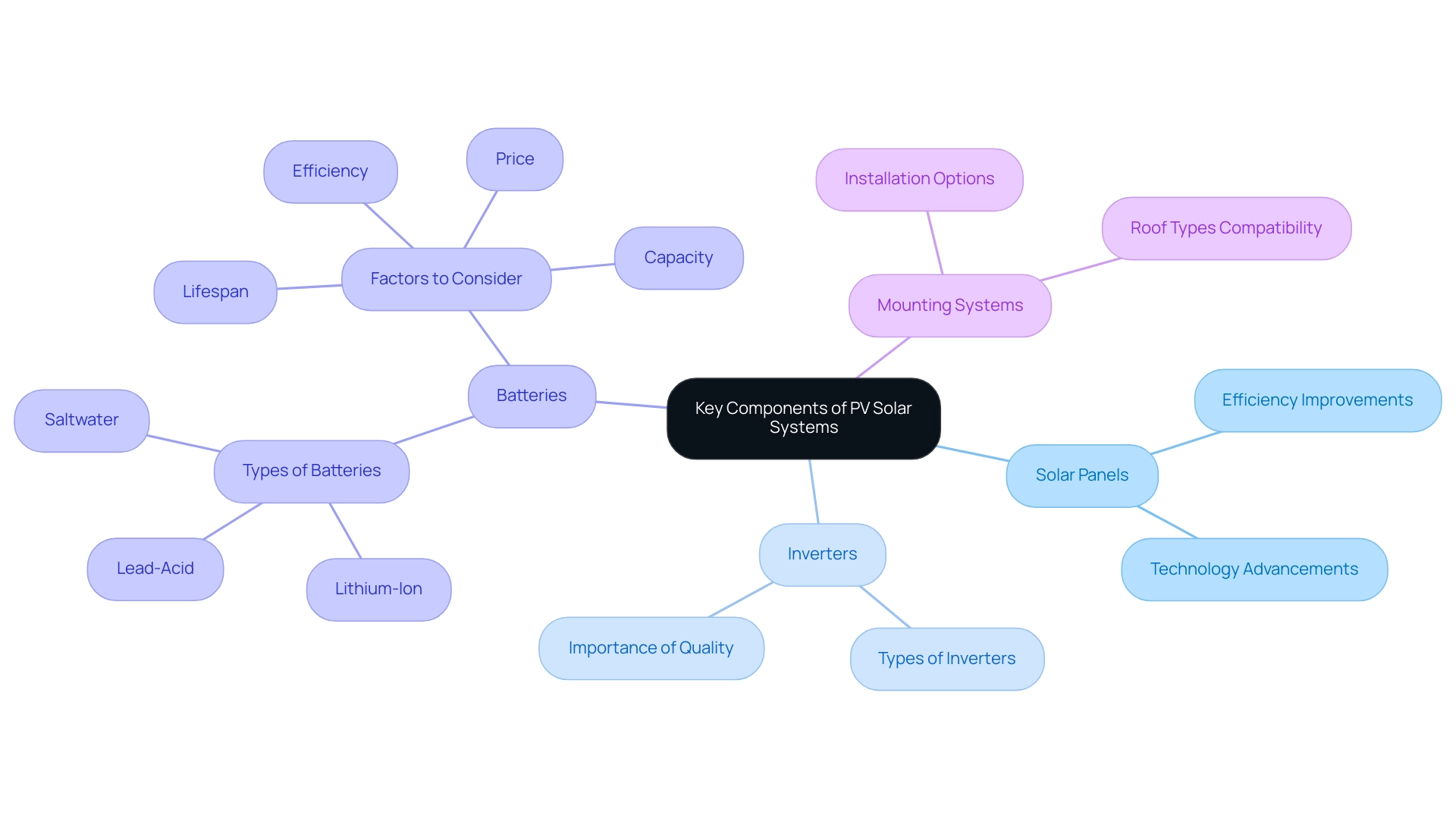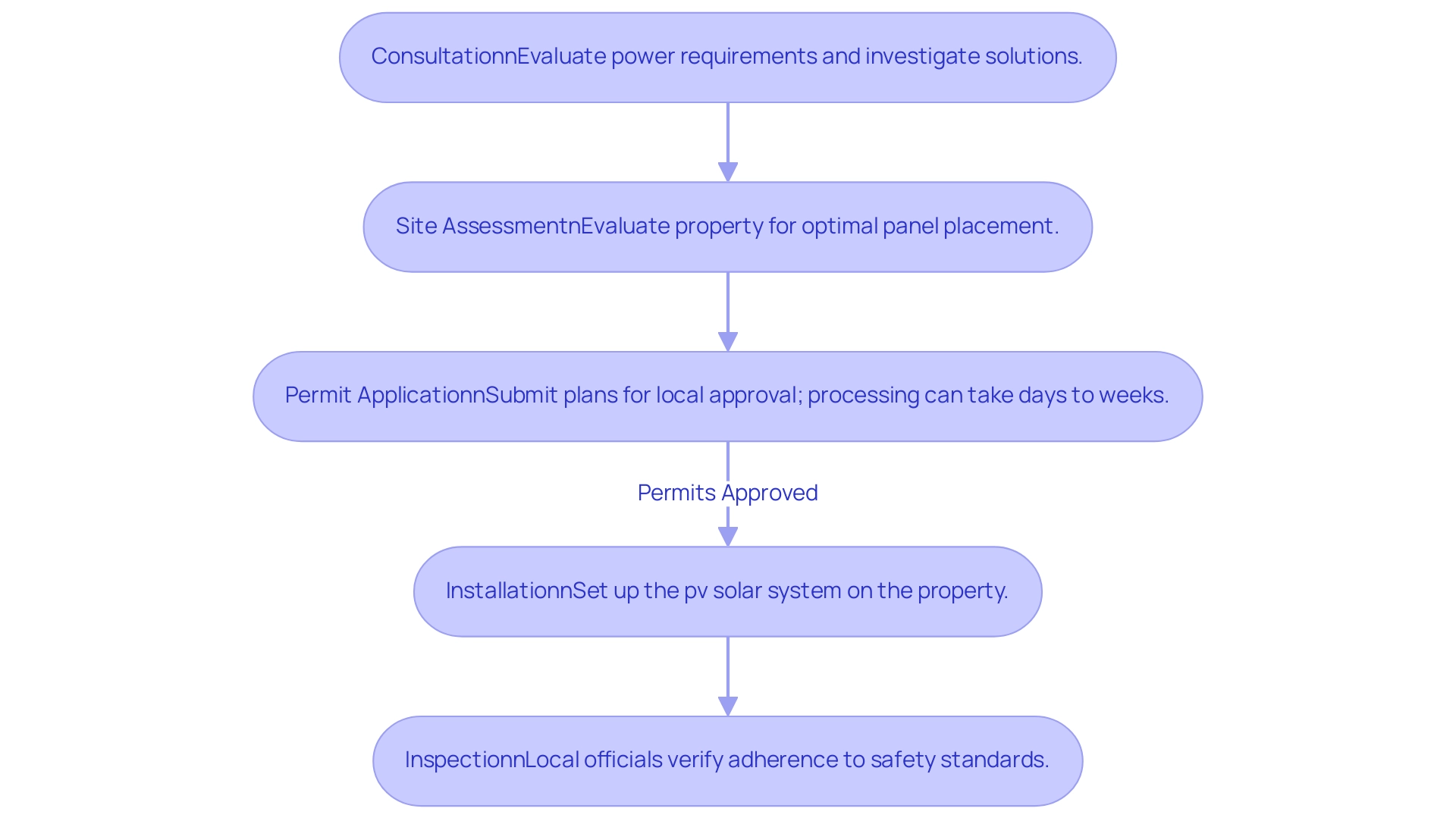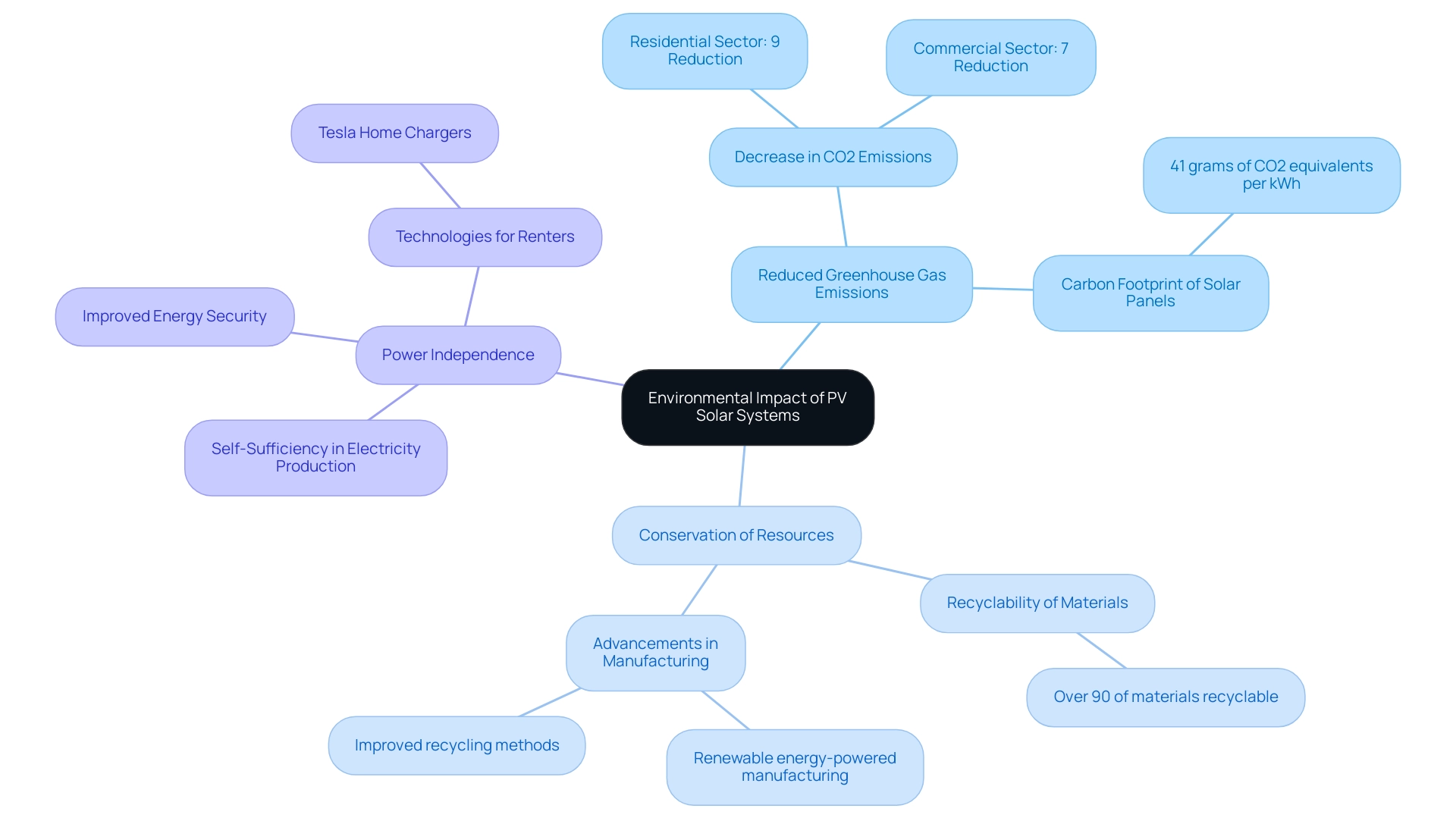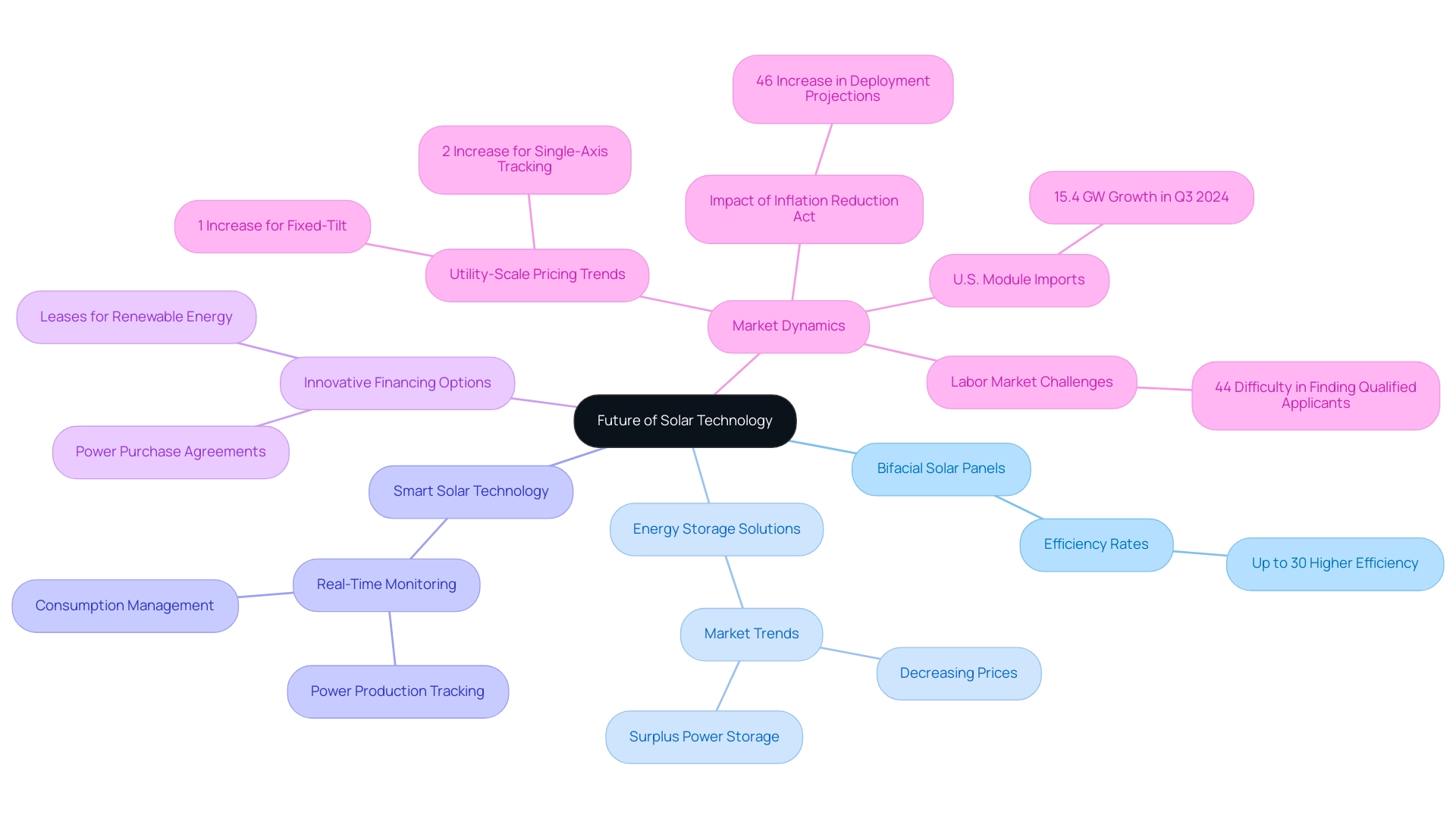Overview
Understanding photovoltaic (PV) solar systems is essential for eco-conscious homeowners as they provide significant benefits, including reduced electricity costs and a lower carbon footprint. The article outlines how these systems operate, their components, financial incentives, and environmental impacts, emphasizing that with proper installation and maintenance, homeowners can achieve long-term savings while contributing to sustainability.
Introduction
In the quest for sustainable energy solutions, photovoltaic (PV) solar systems have emerged as a beacon of hope, converting sunlight into electricity and offering a myriad of benefits to homeowners. As the solar industry experiences unprecedented growth, with new projects being installed at an astonishing rate, the advantages of adopting this technology become increasingly evident. From substantial savings on electricity bills to a marked reduction in carbon footprints, the transition to solar energy is not just an environmental imperative but also a financially savvy choice.
With major corporations leading the charge and innovations in solar technology paving the way for enhanced efficiency, the future of solar energy looks bright. This article delves into the essentials of PV solar systems, exploring their components, installation processes, financial implications, and the profound impact they have on promoting sustainability.
Introduction to Photovoltaic Solar Systems: Basics and Benefits
A PV solar system is designed to transform sunlight directly into electricity through a network of efficient panels, each made up of essential components that capture sunlight effectively. The adoption of a PV solar system offers a multitude of advantages, including substantial reductions in electricity bills, enhanced energy independence, and a positive impact on environmental sustainability by significantly lowering greenhouse gas emissions. In 2023, the renewable energy sector experienced remarkable growth, with a new energy project being installed every 39 seconds.
This momentum is anticipated to persist, with global solar photovoltaic (PV) capacity additions projected to reach between 544 and 876 gigawatts annually from 2024 to 2028, ultimately exceeding five terawatts of total installed capacity by 2028. Homeowners who prioritize proper installation and maintenance of these setups can dramatically reduce their carbon footprint while enjoying long-term savings on energy costs. Specifically, a PV solar system mitigates electricity expenses by generating power from sunlight, thereby offsetting the need to purchase electricity from the grid, particularly during peak hours when rates are elevated.
Major corporations such as Amazon, Google, and Meta are at the forefront of this shift, with a combined contracted pipeline exceeding 25 gigawatts of renewable capacity. As of Q1 2024, nearly 40 gigawatts of photovoltaic capacity and over 1.8 gigawatt-hours of battery storage have been installed by these large entities, underscoring the robust benefits and involvement with renewable sources. Significantly, over 18% of U.S. photovoltaic capacity now involves a corporate offtaker, indicating a strong corporate dedication to renewable power solutions.
This trend not only emphasizes the financial and ecological benefits of renewable sources but also motivates individual property owners to take advantage of these gains. Moreover, homeowners should evaluate best practices for choosing panel inverters for their PV solar system, such as:
- Assessing efficiency ratings
- Ensuring compatibility with their PV solar system
- Consulting with experts to determine the best fit for their power requirements
Furthermore, identifying the necessary capacity for a PV solar system in residences includes evaluating:
- Power usage trends
- Roof area
- Local sunlight exposure factors
For Long Beach tenants, investigating community power initiatives and governmental incentives can offer access to renewable solutions without the requirement for rooftop installations. Recent advancements in photovoltaic panel technology, including AI integration, continue to enhance the efficiency of the PV solar system and reduce costs, solidifying this renewable source as a highly viable option for eco-conscious homeowners.
Key Components of PV Solar Systems: Understanding Your Setup
Photovoltaic (PV) energy setups comprise several essential elements that function together to capture sunlight effectively:
- The [pv solar system serves](https://energy.gov/eere/solar/solar-photovoltaic-system-cost-benchmarks) as the core where solar panels capture sunlight and convert it into electricity. As of 2024, advancements in technology and materials have led to a significant increase in the average efficiency of the pv solar system, making it a more viable option for eco-conscious homeowners.
- Inverters: These devices are essential for converting the direct current (DC) produced by photovoltaic panels into alternating current (AC), the standard electricity format for residential use. Specialists emphasize the significance of investing in high-quality inverters to optimize power conversion and overall performance. Comprehending the hardware expenses related to inverters is essential for property owners assessing renewable energy alternatives, as highlighted by specialist Jennifer Braid.
- Batteries: Although not required, integrating batteries into a pv solar system allows for the storage of surplus power generated during peak sunlight hours, enabling homeowners to utilize this power during cloudy days or at night. This feature significantly enhances energy independence and reliability, aligning with the goal of sustainable living. Common types of batteries include lithium-ion, lead-acid, and saltwater batteries, each with varying specifications and economic benefits. Homeowners should consider factors such as capacity, efficiency, lifespan, and price when selecting a battery.
- Mounting Systems: These structures secure photovoltaic panels to rooftops or ground mounts, ensuring optimal positions for sunlight capture. Recent innovations in mounting technology have introduced flexible installation options that cater to various roof types and orientations.
To effectively manage and maintain a pv solar system, homeowners should follow these steps:
- Evaluate their power requirements
- Investigate and choose suitable panels and batteries
- Consult with experts for installation
Comprehending these components not only illustrates the complexity of energy systems but also underscores their potential efficiency. In Q3 2024, residential installations reached 1.1 GW, marking a substantial contribution to the renewable energy market. As the industry advances, community energy capacity is expected to exceed 15 GW by 2030, propelling further developments in renewable technology. Additionally, case studies, such as the Levelized Cost of Electricity (LCOE) Calculation and the PV Solar System for residential rooftops, demonstrate the economic feasibility and practical applications of these technologies, reinforcing their growing significance in the renewable energy landscape.
Navigating the Installation Process: Permits and Regulations
Installing a pv solar system in Long Beach involves navigating a complex landscape of local regulations and permits. Eco-conscious homeowners should start by consulting their local government or utility company to understand the specific requirements in their area. The installation process typically unfolds in several key steps:
-
Consultation: Participate in conversations with a panel installer to evaluate power requirements and investigate appropriate solutions customized for your residence. Powercore Electric provides professional consultations to assist you in selecting the best options for utilizing and storing energy from a pv solar system.
-
Site Assessment: A thorough evaluation of the property is conducted to determine optimal panel placement, ensuring maximum efficiency and energy production.
-
Permit Application: Plans are submitted to local authorities for approval.
This step is crucial, as records indicate that about 53% of homes built before 2000 required an electrical permit. Homeowners should be prepared for an average processing time that can range from a few days to several weeks. Notably, having roofing permits can lead to shorter processing times, potentially expediting the overall timeline.
Powercore Electric can assist in obtaining necessary roofing permits to streamline this process.
-
Installation: Once permits are approved, the setup of the pv solar system can commence, effectively transforming your property into a renewable energy-producing site.
-
Inspection: After installation, local officials will conduct an inspection to verify that the setup adheres to safety standards and regulations.
Recent reforms in states like California and New York highlight the potential for streamlined processes, as noted by Katrina McLaughlin, who emphasized that recent state permitting reforms offer valuable lessons for other states and Congress.
It’s worth noting that a 4% decline in residential energy installations in Q3 2024 was observed due to high electricity bills, power outages, and changes in California’s net metering rules. This decrease could affect property owners’ choices and schedules for shifting to renewable power. However, emerging markets are expected to drive growth in the latter half of the decade.
Homeowners should also explore government programs that offer financial incentives for renewable energy installations, making the transition more accessible. By adhering to these steps and taking into account the services provided by Powercore Electric, Long Beach renters and property owners can streamline the installation process, ensure adherence to local regulations, and create a path for a successful shift to renewable resources while addressing increasing utility expenses through efficient alternatives.
Financial Considerations: Costs, Savings, and Incentives for Solar PV
The cost of a pv solar system can vary significantly, influenced by factors such as the size of the system, quality of components, and complexity of installation. In 2024, typical costs are expected to range from approximately $15,000 to $30,000 before applying any incentives. Eco-aware homeowners may see significant savings on their electricity expenses, frequently lowering costs by 50% or more when transitioning to renewable sources.
Financial incentives play a vital role in making renewable energy adoption more accessible, including:
- Federal Tax Credit: A 26% federal tax credit is available for photovoltaic installations, applicable through 2022 and expected to decrease gradually in the following years.
- State Incentives: Various states offer additional rebates that can significantly lower upfront costs. For instance, California benefits from the lowest average installation costs in the nation, making it a prime market for renewable energy solutions, although recent challenges like queue depletion and higher financing costs have impacted installations in early 2024.
- Net Metering: This permits homeowners to sell any surplus energy produced back to the grid, further reducing their overall expenses.
Comprehending these financial aspects is crucial for homeowners seeking to optimize the advantages of renewable energy, especially under the 200% rule, which allows for a greater capacity in relation to household energy usage. For example, a family in California installed a 10 kW energy system under the 200% rule, resulting in a significant reduction in their monthly electricity costs and an increase in their home’s value. Notably, over 30 GW of pv solar system capacity has been installed as of Q3 2024, with expectations to sustain an annual deployment of 40-45 GW of pv solar systems over the next five years.
The Inflation Reduction Act has strengthened market confidence, resulting in a projected 46% rise in photovoltaic deployment compared to pre-IRA forecasts, despite challenges in interconnection and labor availability. Additionally, the Minimum Sustainable Price (MSP) and Modeled Market Price (MMP) are crucial for understanding cost dynamics in the renewable energy market. By utilizing accessible financial incentives and comprehending the expense distribution of a pv solar system, property owners can make educated choices that result in considerable long-term savings while enhancing the benefits of renewable power.
As the Department of Energy states, ‘The Department of Energy’s Solar App+ aims to make the interconnection process cheaper and quicker for everyone,’ highlighting ongoing efforts to improve accessibility in renewable power adoption.
Environmental Impact: How PV Solar Systems Promote Sustainability
Photovoltaic (PV) installations, or a pv solar system, are crucial in promoting sustainability by efficiently capturing renewable resources, making them a great option for environmentally aware homeowners, particularly renters in Long Beach seeking to utilize photovoltaic solutions. By transforming sunlight into electricity, these setups play a vital role in reducing dependence on fossil fuels, which are major contributors to climate change. The environmental advantages of adopting renewable energy include:
- Reduced Greenhouse Gas Emissions: The incorporation of a pv solar system has significantly contributed to a notable decrease in carbon footprints, with overall CO2 emissions associated with electricity consumption in residential areas dropping by 9% in 2023. The Intergovernmental Panel on Climate Change (IPCC) estimates that the carbon footprint of rooftop photovoltaic systems is approximately 41 grams of CO2 equivalents per kWh of electricity produced.
- Conservation of Resources: By transitioning to sunlight-based energy, we conserve precious non-renewable resources such as coal and natural gas. Recent developments indicate that over 90% of the materials used in panel production are recyclable, which decreases downstream emissions and reduces the demand for raw materials. Furthermore, advancements in renewable energy-powered manufacturing and improved recycling methods can further lessen the carbon footprint of photovoltaic panels.
- Power Independence: Homeowners can produce their own electricity through a pv solar system, thereby reducing their reliance on the grid and improving overall power security. This self-sufficiency contributes to a more resilient energy infrastructure.
In addition to these environmental benefits, Long Beach renters can explore specific technologies such as Tesla home chargers and various panel functionalities that cater to their unique needs. Economic advantages encompass possible reductions in electricity costs and access to financial incentives and programs aimed at promoting the use of renewable energy for renters. By embracing sunlight energy, individuals actively support a healthier planet for future generations while tapping into incentives that align with broader sustainability efforts advocated by organizations such as the Energy Industries Association (SEIA), emphasizing comprehensive climate and energy legislation to protect clean air and promote renewable energy adoption.
The Future of Solar Technology: Trends and Innovations in PV Systems
The future of solar technology is becoming more encouraging, with numerous innovative trends and advancements poised to revolutionize the pv solar system in the upcoming years. Key developments include:
-
Bifacial Solar Panels: These cutting-edge panels harness sunlight from both the front and rear sides, significantly boosting efficiency rates.
Recent statistics indicate that bifacial panels can achieve efficiency levels up to 30% higher than traditional panels, making them an attractive option for eco-conscious homeowners.
-
Energy Storage Solutions: The market for advanced battery systems is expanding rapidly, with prices decreasing significantly. This trend allows homeowners to store surplus power generated during the day for nighttime use, optimizing consumption and reducing reliance on the grid.
Significantly, assessments of leading solar batteries uncover characteristics and market trends that can direct consumer decisions in storage.
-
Smart Solar Technology: The integration of a pv solar system with smart home technology is transforming resource management. Homeowners can now monitor their power production and consumption in real-time, leading to more informed utility decisions and enhanced efficiency.
-
Innovative Financing Options: New financing models, including power purchase agreements and leases for renewable energy, are making installations more accessible and affordable for homeowners. Such choices allow individuals to embrace renewable resources without the strain of high initial expenses.
In the wider economic landscape, utility-scale system pricing has experienced a rise of 1% for fixed-tilt and 2% for single-axis tracking annually, indicating persistent market dynamics. Moreover, the passage of the Inflation Reduction Act has significantly improved baseline projections for the renewable energy sector, boosting expected deployment by 46% compared to pre-IRA projections. This policy shift highlights the significance of remaining updated on contemporary trends and their effects on property owners, especially concerning the financial benefits accessible through government initiatives that promote renewable energy adoption.
Additionally, recent insights into the pv solar system encompass Tesla home chargers, panel functionality, government programs, cleaning services, and battery storage solutions. A recent case study indicates that U.S. module imports grew to nearly 15.4 GW in Q3 2024, highlighting the ongoing challenges and opportunities within the energy market. As the renewable energy sector keeps advancing, innovations like these will enable property owners to adopt efficient energy strategies while aiding in a sustainable future.
Furthermore, comparing different energy service providers reveals that some companies offer better integration options for electric vehicles, enhancing the overall value proposition for eco-conscious homeowners. According to Wood Mackenzie, our current outlook for the next five years has the US solar industry growing 2% per year on average, underscoring the importance of staying informed about these trends.
Conclusion
The rapid growth of photovoltaic (PV) solar systems is transforming the energy landscape, providing homeowners with significant benefits that extend beyond mere cost savings. By harnessing sunlight to generate electricity, these systems not only reduce electricity bills but also play a crucial role in lowering carbon emissions and promoting environmental sustainability. With major corporations and advancements in technology driving this trend, the future of solar energy appears increasingly bright.
Understanding the key components of PV solar systems—such as solar panels, inverters, batteries, and mounting systems—empowers homeowners to make informed decisions about their energy needs. The installation process, though complex, can be navigated successfully with the right guidance, ensuring compliance with local regulations and maximizing system efficiency. Financial incentives further enhance the appeal of solar energy, allowing homeowners to capitalize on substantial savings while contributing to a more sustainable future.
As the solar industry continues to innovate, emerging technologies like bifacial panels, advanced energy storage solutions, and smart home integrations are set to revolutionize the way households manage energy consumption. By embracing these advancements, individuals not only secure their energy independence but also support a larger movement towards renewable energy adoption.
Ultimately, the transition to solar energy is not just a personal investment; it is a commitment to a healthier planet for future generations. By taking advantage of available resources and trends, homeowners can join the solar revolution, ensuring that their energy choices align with both economic benefits and environmental stewardship.


